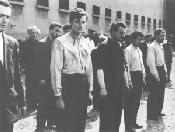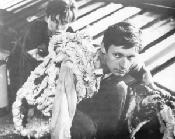 by François Truffaut 
To the degree that Un Condamné à Mort s'est échappé is radically opposed to all conventional directorial styles, it will, I believe, be better appreciated by audiences who go to the movies only occasionally, say once a month, than by the nonmovie-loving but more assiduous public whose sensibilities are often confused by the rhythm of American films. What is striking when one sees the film for the first time is the constant contrast between what the work is and what it would be, or would have been, if it had been made by another filmmaker. At first all one sees are its deficiencies, and for a while one is tempted to redo the cutting and indicate additional shots so that the film would resemble "what a film is supposed to be." Indeed, everybody pointed out the lack of any establishing shots—one would never know what Fontaine saw through his tiny window or from the roof of the prison. Thus, at the end of a first viewing, surprise might win out over admiration. And André Bazin felt moved to explain that it was easier to describe what the film was not than what it was. It really must be seen again to appreciate its beauty perfectly. On second viewing, nothing any longer gets in the way of our keeping up, second by second, with the film's movement—it's incredibly swift—and walking in Leterrier's or Bresson's still-fresh footprints, whichever of them left them. Bresson's film is pure music; its essential richness is in its rhythm. A film starts at one point and arrives ultimately at another. Some films make detours, others linger calmly for the satisfaction of drawing out a pleasant scene, some have noticeable gaps, but this particular film, once set on its perfectly straight path, rushes into the night with the same rhythm as a windshield wiper; its dissolves regularly wipe the rain of images at the end of each scene off the screen. It's one of those films which can be said not to contain a single useless shot or a scene that could be cut or shortened. It's the very opposite of those films that seem like a "montage," a collection of images. Un Condamné à Mort s'est échappé is as free-style and nonsystematic as it is rigorous. Bresson has imposed only unities of place and action; it's not only that he has not tried to make his public identify with Leterrier, he has made such identification impossible. We are with Leterrier, we are at his side; we do not see everything he sees (only what relates to his escape), but never do we see anything more than he does. What this amounts to is that Bresson has pulverized classic cutting—where a shot of someone looking at something is valid only in relation to the next shot showing what he is looking at—a form of cutting that made cinema a dramatic art, a kind of photographed theatre. Bresson explodes all that and, if in Un Condamné the closeups of hands and objects nonetheless lead to closeups of the face, the succession is no longer ordered in terms of stage dramaturgy. It is in the service of a preestablished harmony of subtle relations among visual and aural elements. Each shot of hands or of a look is autonomous. Between traditional directing and Bresson's there lies the same space as between dialogue and interior monologue. Our admiration for Robert Bresson's film is not limited to his wager—to rest the entire enterprise on a single character in a cell for ninety minutes. The tour de force is not all. Many filmmakers—Clouzot, Dassin, Becker, and others—might have made a film that was ten times more thrilling and "human" than Bresson's. What is important is that the emotion, even if it is to be felt by only one viewer out of twenty, is rarer and purer and, as a result, far from altering the work's nobility, it confers a grandeur on it that was not hinted at at the outset. The high points of the film rival Mozart for a few seconds. Here, the first chords of the Mass in C Minor, far from symbolizing liberty, as has often been written, give a liturgical aspect to the daily flushing of the toilet buckets. 
I don't imagine that Fontaine is a very likable personality in Bresson's mind. It isn't courage that incites him to escape but simply boredom and idleness. A prison is made to escape from, besides which, our hero owes his success to luck. We are shown Lieutenant Fontaine, about whom we shall know nothing more, in a period of his life when he is particularly interesting and lucky. He talks about his act with a certain reserve, a bit like a lecturer telling us about his expedition as he comments on the silent movies he has brought back: "On the fourth, in the evening, we left the camp...." Bresson's great contribution clearly is the work of the actors. Certainly James Dean's acting, which moves us so much today, or Anna Magnani's, may risk our laughter in a few years, as Pierre-Richard Wilm's does today, while the acting of Laydu in Le Journal d'un Curé de Campagne and of Leterrier in Un Condamné will grow more forceful with time. Time always works for Bresson. In Un Condamné the Bresson style of directing achieves its finest results. We are no longer offered the quiet voice of the little parish priest of Ambricourt, or the gentle look of the "prisoner of the holy Agony," but the clear, dry diction of Lieutenant Fontaine. With his gaze as direct as that of a bird of prey, he hurls himself on the sacrificial sentinel like a vulture. Leterrier's acting owes nothing to Laydu's. "Speak as if you were talking to yourself," Bresson commanded him. He exerts all his effort to filming the face, or, more accurately, the seriousness of the human countenance. "The artist owes a great debt to the countenance of man; if he cannot manage to evoke its natural dignity, he should at least attempt to conceal its superficiality and foolishness. Perhaps there's not a single foolish or superficial person on this earth, but simply some who give that impression because they are ill at ease, who have not found a corner of the universe in which they feel well." This marvelous reflection of Joseph von Sternberg's is, to my mind, the most apt comment on Un Condamné. To think that Bresson will be an influence on French and foreign contemporary filmmakers seems highly unlikely. Nonetheless, we clearly see the limitations of the other cinema to the advantage of this film. The risk is that it may make us too demanding of the cruelty of Clouzot, the wit of René Clair, the carefulness of René Clément. Much remains to be discovered about film art, and some of it can be found in Un Condamné. —1956
Reprinted in The Films in My Life (New York: Simon & Schuster, 1978), p. 193-196.
[ home | films | directors | actors | articles | other stuff ]
This page was last updated on 14 November 1998. irmavep@oocities.com |